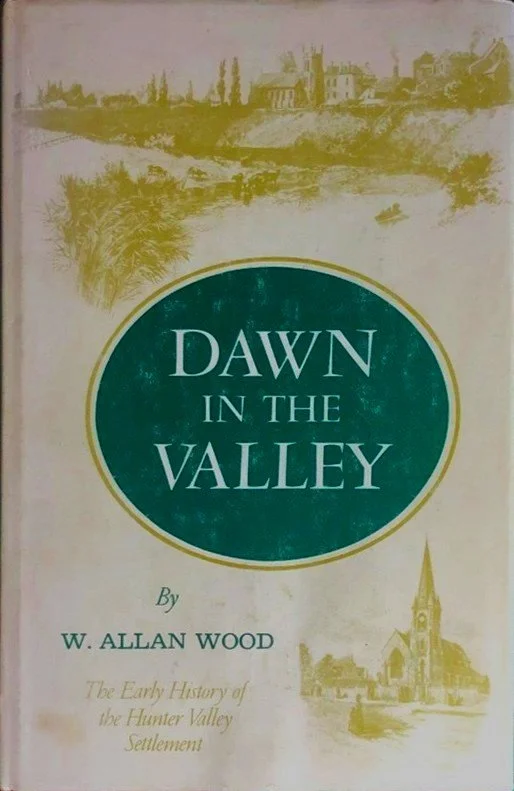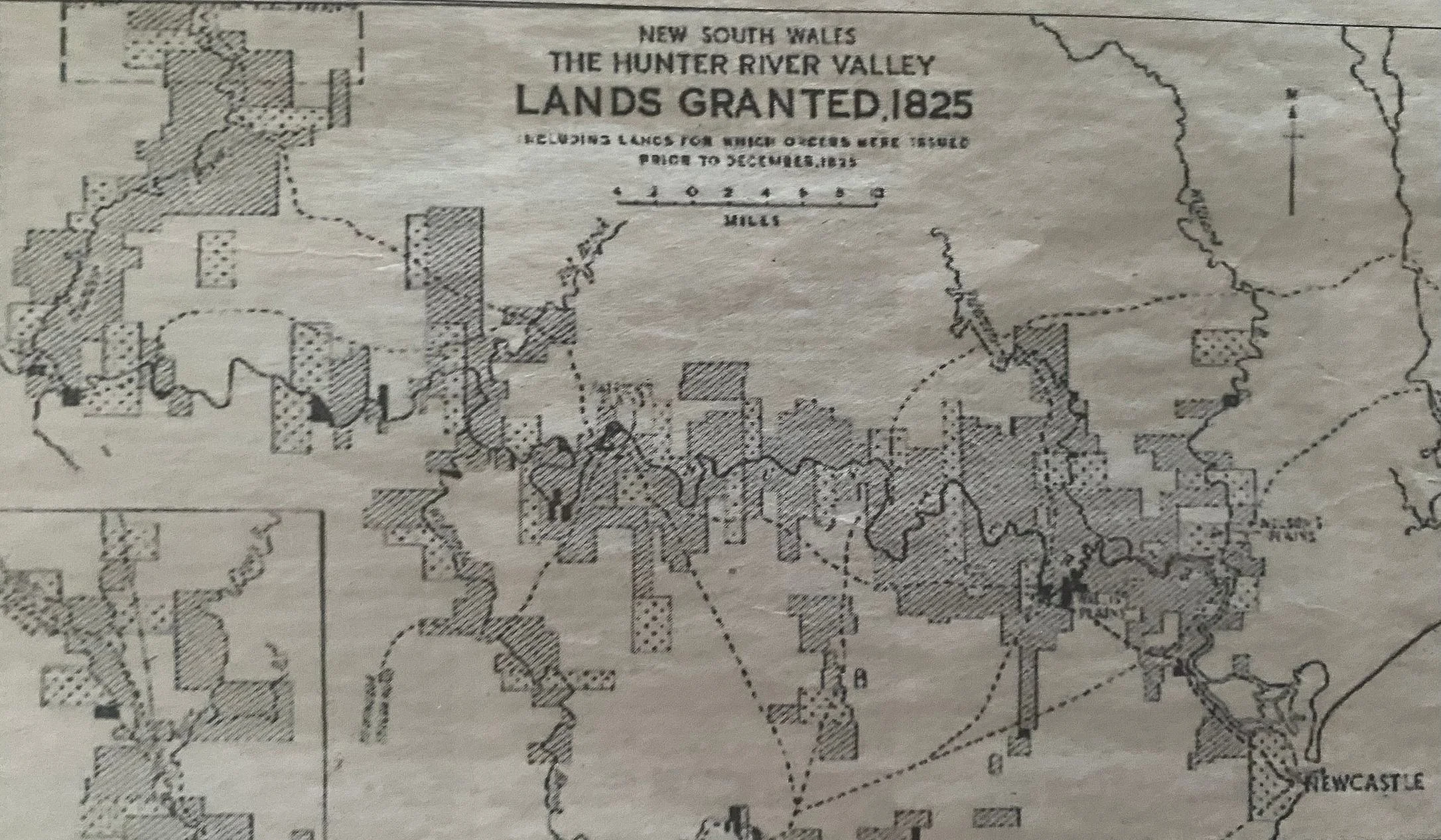Maitland, circa 1830
In 1830, the tiny convict-based farming community of Wallis Plains, founded and named by Governor Lachlan Macquarie in 1818, was much changed from what had been established initially. Part of Wallis Plains was soon to become known as West Maitland. This was a wild, noisy, pulsating, sometimes violent town of a few hundred people centred on a small collection of wharves and a rough track that led northwards to the interior of the colony. It comprised houses and inns clustered near the confluence of Wallis Creek and the Hunter River, with a few more buildings scattered to the north and south. Development was beginning in East Maitland and Morpeth as well, and the Hunter Valley had been surveyed and opened up for agricultural settlement.
The area described
A description of the nascent town at this time, arguably not bettered since, comes from W Allan Wood’s 1972 classic, Dawn in the Valley:
Maitland was a raw and vigorous settlement of new and old colonists . . . a disordered camp of waterborne strangers - the land-hungry of all degrees, buyers and sellers of all commodities, enterprising breakers of new ground for the reaping of usurers on the make. Here was the starting point for all new settlers bound for the upper districts; a halting-place for dusty or mud-caked riders and teamsters from the inland; a long street of carousal for the road-weary, the restless, the resentful, the lawless and the despairing. It was just another place of labour for the prisoner, a scene of riotous and bloody assemblages of ticket-of-leave men and women . . . and of drunken, brawling mobs.
Here was also a land of promise for those whose freedom was gained by servitude, and for others who voluntarily left home and kin to sail in crowded ships on unsafe seas around half the world, to plant a vine and fig tree of their own, or with an immediate prospect of food and lodging plus a yearly wage no greater than the payment of many convicts. Skilled craftsmen came here to become masters, hawkers to be merchants, inn-keepers to control many affairs of commerce and industry, and men with capital to lose all.
Travellers on the long High Road of Maitland were greeted from house to house by a tumult of assorted shrill whistles, shrieks, raucous laughter, jeers . . . suggestive invitations and lewd insults . . . [It was] a lusty, bustling, rowdy, haphazard town of private enterprise.
The cover of Allan Wood, Dawn in the Valley
Function and growth
Wallis Plains had become a town of opportunity, a place where one could make good - or lose whatever had been made. It was a rough frontier town, not for the faint-hearted, with law and order not much evident. But it had a functioning economy. Shops were established from 1825 when William Powditch and Frederick Boucher opened their store next to the wharf that initiated the port where the river bordered Wood’s High Road. The High Road would in due course become High St.
Shallow-draft vessels (droghers) plied the river, bringing manufactured items from Sydney up from the port at Morpeth, first known as Green Hills, and taking the product of the farms of the inland downstream on its way to Sydney.
Livestock was driven through the little town every day, heading up the valley to the holdings of the settlers. Land transport difficulties were being addressed, with bridges over the swamp at Veterans Flat (1825) and across Wallis Creek (1827) facilitating movement north and south. Large agricultural estates had been established on the floodplains, stretching to the upper Hunter and beyond the Great Dividing Range, their owners creating a demand for goods and services sold in West Maitland. New businesses were setting up, and the place was growing almost by the day.
With Newcastle much shrunken by the transferral of the penal function to Port Macquarie in the mid-1820s, West Maitland had become the larger of the two towns in the Hunter Valley. East Maitland and Morpeth as separate entities had not yet taken on ‘urban’ forms.
The vigorous two-way traffic through the area demanded accommodation and other services. Retailing had become established, a range of wares being brought in. Regular boat services were operating, as many as six vessels working the river between Morpeth and the nascent Port at West Maitland.
A grain store quickly appeared close to the original wharf as did a cattle yard, sheds and warehouses, and a small number of other wharves were built. The Port had become the core of the town’s economy, stimulating the development of its original Central Business District which grew along the High Road. Several inns were trading as well, among them the Angel Inn owned by leading citizen Molly Morgan. Government services developed, a post office being established in 1829 and creating a regular mail delivery service linking the area with Newcastle and Sydney. Merchants, traders and their agents could now communicate relatively efficiently and thus organise commercial transactions at a distance from each other.
Buildings and businesses next to the river at the site of the wharves, 1829
(Peter F Smith, 2023, p286)
There was a brewery, a bakery and a bank (the Bank of Newcastle), and occupations recorded in the 1828 census included sawyers, a stonemason and a plasterer. A construction industry had developed, with some specialisation developing. Employment for women was largely confined to domestic service, though a small number ran their own businesses as milliners, dressmakers and seamstresses. A very few were governesses in the homes of the wealthy, but schools as we now know them were in their infancy in 1830 and female teachers were still largely in the future.
At the tiny port and along the High Road a town comprising retail, service and manufacturing activities had evolved on top of the semi-subsistence farming economy established by convict farmers a few years earlier. That first economy had by 1830 been virtually supplanted by the development of commercial agriculture on the large rural estates nearby, and the original convict settlers of an entrepreneurial bent like Molly Morgan and John Smith had largely abandoned active farming for inn-keeping and construction respectively.
The estates, growing in number and in population, supported a construction supply industry, tools and materials being brought from Sydney. Agricultural implements - hoes, ploughs and the like - bulked large in the items brought in by ship to Morpeth and by drogher further up the river.
Land granted by 1825, Hunter Valley
(NSW State Archives: NRS 13859 [SZ550] W.633 J Abbott, Wallis Plains – Survey of O’Donnell’s 33 acres with the adjoining buildings, Dec 1829 (detail). NSW State Archives: NRS 13859 [SZ550] W.633.)
The range of imported items incorporated household consumer goods as well as items used in agricultural and industrial activities. Those who lived on the estates looked to the port and the High Road for their needs. Wallis Plains had become the ‘central place’ of the Hunter Valley, the location where shopping and service needs could be satisfied. Filling with farmers and their convict labourers, the valley was creating demands that fuelled the growth of urban activities. The ‘hub of the Hunter’ and the ‘capital of the North’ was taking shape in what was, during the 1840s, to become the second-largest urban centre in the colony, eclipsing Parramatta and Windsor.
There was in 1830 only a small population in what is now East Maitland and few dwellings and inns. Some people lived and worked at the port at Morpeth where the 170-ton store ship St Michael (a former convict ship) had been moored since 1828. It functioned as both a wharf and a shop, people buying items from the St Michael using either grain or cash. Loading and unloading ships and droghers was an important source of work at Morpeth.
The basis for future growth
The areas soon to be known as West Maitland, East Maitland and Morpeth probably had fewer than 1000 people between them in 1830, by far the majority of them living in the future West Maitland. But a vibrant, growing economy had been established. It was based on two-way transport links to Sydney and to the expanding frontier of the inland, and on the demands and produce of the large estates. Further growth was guaranteed. By 1841 the population of West Maitland, East Maitland and Morpeth had grown to more than 2700.
References
Keys, Chas, ‘Our past: in 1830 Maitland was a town of opportunity’, Maitland Mercury, 1 October 2021.
Keys, Chas, ‘Our past: West Maitland becomes the “hub of the Hunter”’, Maitland Mercury, 8 October 2021.
Smith, Peter F, The Footprints of Maitland’s Old Hands Trilogy: an untold history for a new generation. Book One: Maitland’s Rise, The Hill, the High Road and the River Flats, the author, Bloomington, Indiana, 2023.
Turner, J, The Rise of High Street, Maitland: a Pictorial History, second ed., Council of the City of Maitland, Maitland, 1989.
Wood, W Allan, Dawn in the Valley: the Story of Settlement in the Hunter Valley to 1833, Wentworth Books, Sydney, 1972.



